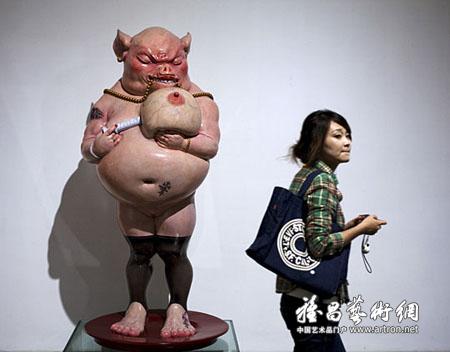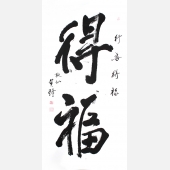- 资质:AGA 艺
- 评分:
1分 2分 3分 4分 5分 6分 7分 8分 9分 10分 2分
- 印象:
- 经营时间:20年
- 展厅面积:
- 地 区:北京-东城
Sky-High Chinese Art Market Comes Back To Earth
2011-04-15 10:15:13

Visitors admire artwork on display at the SH contemporary art fair, China's largest international exhibition of its kind, in Shanghai, on Sept. 12. Since then, the once-hot Chinese contemporary art market has cooled.
One index outperformed every single stock market over the past five years: the contemporary Chinese art market.
As of January, it had rocketed up 583 percent from five years earlier, according to an index by the auction tracking site Artprice.
But, like so many other markets, it was driven by speculation and greed. And now, that bubble has burst.
In September, the doors of the SH contemporary art fair in Shanghai had been open just five minutes when a Chinese businesswoman bought an oil painting from Yan Qing's Aye gallery for $40,000.
An abstract work by artist Wang Guangle, it was a blocky, black square with thin white lines straggling across a canvas, bisected with a thick white stripe.
Gallery owner Yan Qing was confident it was a good buy.
"It's not cheap, but the buyer liked it a lot and is very decisive," she said at the time. "For good artworks, I don't think it's a bubble; they won't devalue. Each one is an original, so they can only rise in value."
Reasons For Cooling Market
How much difference half a year makes. Last year, 11 of the world's top 20 best-selling artists were Chinese. Work by just one of those, Zhang Xiaogang, raked in $44 million at auction in 2008 alone.
But in October, as crisis after crisis buffeted Wall Street, Sotheby's sale of contemporary Chinese art bombed. Just 39 of 110 paintings sold at the auction, which is widely seen as an indicator of the health of the Chinese contemporary art market.
Since then, things have gotten even worse, according to Brian Wallace of Red Gate Gallery in Beijing.
"In terms of the overall market, I would say it's probably dropped by at least 50 percent, just in this short period, and we'll see how that pans out over 2009," says Wallace, an 18-year veteran of the China art market.
Wallace blames a combination of factors, including the financial crisis, a falling number of visitors to galleries, and the reality that, because of the bubble, perhaps prices were too high.
"We all knew that was going to end, but we weren't expecting it right now," he says.
When asked how much further the market will fall, Wallace laughs nervously. "We don't know, because we haven't had this experience before," he says.

A visitor walks past Happy Life, a fiberglass sculpture by Chinese artist Chen Wenling, on display at the 798 Art District in Beijing on Oct. 4. More than 30 galleries in the district have closed recently.
Beijing Gallery District Suffers
Beijing's 798 Art District is one victim of the slowdown. A motley assortment of artists, galleries and cafes sprang up among the warehouses of an old electronics factory in northwestern Beijing, making it the capital's premier art destination.
Local press reports say that 37 art galleries have closed down in the district within the past few months.
"They say the rent's too high," says Duan Changwu, who owns a kiosk selling drinks in the district, pointing to a row of padlocked galleries. "Because of the financial crisis, they can't sell any pictures."
Insiders say there has been an exodus from Beijing by artists from the provinces, who'd been attracted to the capital's vibrant art scene — and its money-making possibilities. Now, with their finances pinched, many are packing up and going home.
Time For Artists To 'Get Back To Basics'
Art galleries and museums that remain open are cutting back drastically on their shows to save money. According to a recent survey by the art market research firm ArtTactic, 72.7 percent of respondents have a negative view on the short-term outlook for the Chinese contemporary art market. But despite the gloom, not everybody is pessimistic.
"The financial crisis is a good thing for Chinese contemporary art," says artist Pu Jie as he draws on a cigarette, while admiring his towering, sunflower-yellow canvases.
The 50-year old, whose work has sold at Sotheby's for tens of thousands of dollars, is busy preparing for two solo shows this year: one in Tokyo, one in Beijing. He has been painting a 60-foot-long series of panels of yellow-tinted, apple-cheeked revolutionary women, overlaid with cartoon-like, partly clad, thoroughly modern madams.
Pu Jie says it is time for artists to get back to basics.
"Everybody was busy doing exhibitions, selling pictures, doing deals with galleries. Everybody was playing the market instead of thinking about the essence of art," he says. "Now, the economic crisis should make us think soberly about what sort of art we are making."
Making Art Fell Victim To Making Money
Even as the Chinese contemporary art market reached ever more dizzying heights, its fundamentals were shaky. Tales of dirty dealing by artists were legion; some artists bought back their own works at auction to push the prices up; others secretly offered "buy one, get two free" deals at auction; some even signed contracts with middlemen, paid to inflate the price of their art.
ArtTactic has a "speculation barometer" measuring the perceived level of speculation in an art market; the level for the contemporary Chinese market was 73 percent higher than for the Western contemporary art market.
Independent curator Zhu Qi believes up to 80 percent of transactions in China were "fake" or pumped up. For some artists, making money began to take precedence over making art, he told NPR in an interview recorded late last year.
"Artists don't even have time to paint," Zhu Qi said. "They employ others to draw for them, then they just sign the pictures.
"In the late '80s, art criticized social realities, but those critical voices no longer exist. Now, the older artists are all stars and millionaires. And younger artists think it's better to simply turn art into a concrete, tangible commodity. They don't care about history and society, they just care about themselves."
Still, New Galleries Opening
Now, though, the market has come tumbling back to earth. But for some, Chinese art is still promising.
Yan Qing — the gallery owner who sold a painting within five minutes at the Shanghai art fair last year — is actually opening an enormous new space in Beijing named Aye Eastation.
The 10,000-square-foot gallery will be filled with works by artists who had been the brightest stars in the contemporary art firmament, such as Zhang Xiaogang, Fang Lijun and Yue Minjun.
"We're not giving in," Yan Qing says. "We're running against the tide."
But the name of the new gallery's first exhibition — "China's Revision" — can be seen in a whole new light these days.
上一篇:“迹•象”五人版画艺术展
下一篇:展览《东站•回望中国》隆重开幕

 黄琦
黄琦 测试用艺术
测试用艺术




